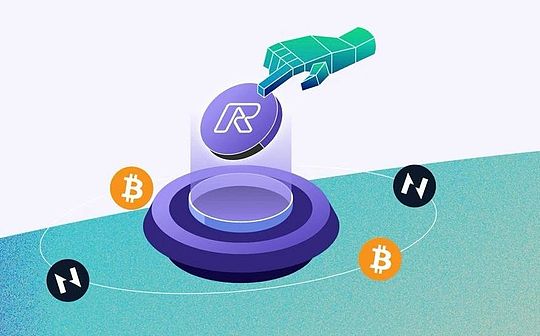
Author: Bai Ding & Vicent Zhao, Geek web3
Camus once said in “The Plague”: “To find out about a city is nothing more than how the people there work, love each other, and die.”If you want to examine the ecosystem of a public chain, the first thing people look at is how many DeFi protocols, how high TVL, and how many application scenarios there are.It can be said that Defi data directly reflects the rise and fall of public chains. Although this set of judgment criteria has many shortcomings like GDP, it is still regarded as the primary reference framework by observers today.
In terms of business model, modern DeFi is inseparable from the four most basic suites: DEX, lending, stablecoins, oracles, and on this basis, there are LST, derivatives, etc. These things are common in the EVM ecosystem, but in the BTC ecosystemIt is extremely scarce, and for this reason, countless projects under the banner of BTCFi and BTC second-tier BTC have emerged.
But to this day,Many flaws in the second layer of BTCFi and BTC have been exposed. Most projects only build an EVM Chain in the Bitcoin ecosystem. DAPPs are basically moved by Ethereum, which seems to have the taste of using Bitcoin as an Ethereum colony.While these EVM Chain are homogeneously revolving, there is basically nothing refreshing and no interesting stories.
In contrast, UTXO public chains such as CKB and Cardano may be more attractive than EVM Chain.Previously, based on the characteristics of the UTXO model, Cipher, the founder of RGB++ Layer, proposed the “isomorphic binding” and “Leap bridgeless cross-chain” solutions, which once attracted countless people’s attention; combined with Intent and order book-friendly UTXOSwap, based onThe ccBTC with equal mortgage and the JoyID wallet that is adapted to multi-chain support Passkey technology are obviously also remarkable.

However, for the CKB and RGB++ Layer ecosystems, a major focus is on their stablecoin system, which is a hub in various Defi scenarios.Whether there is a stable and reliable stablecoin issuance agreement will directly affect the ecological landscape. In addition, it is also very important whether it can provide a suitable circulation environment for stablecoins.For example, USDT was first issued with the Bitcoin Omni Layer protocol, but because the smart contract environment provided by Omni Layer is poor, USDT eventually gave up Omni Layer, which shows that stablecoins are the most suitable only in a complete smart contract environment.of.

(Photo source: Wikipedia)
In this regard, RGB++ Layer based on CKB can create an excellent circulation environment for stablecoins in the BTCFi ecosystem with its Turing complete smart contract environment and native AA and other surrounding facilities.In addition, because many large investors are accustomed to holding BTC for a long time rather than using it to interact frequently,If you can use BTC as collateral to issue stablecoins while ensuring safety, it can leverage the enthusiasm of big investors to interact with BTCFi and improve the capital utilization rate of BTC.It can also reduce people’s dependence on centralized stablecoins.
Hereinafter, we willInterpretation of Stable++, a stablecoin protocol within the RGB++ Layer ecosystem, which uses BTC and CKB as collateral to generate RUSD stablecoins. Combined with the Stability Pool insurance pool and bad debt redistribution mechanism, it can provide reliable stability for BTC and CKB holdersCoin minting scene.Combined with CKB’s unique issuance method, Stable++ can build an underdamping system within the RGB++ ecosystem, which can play a moderate buffering role when the market fluctuates violently.
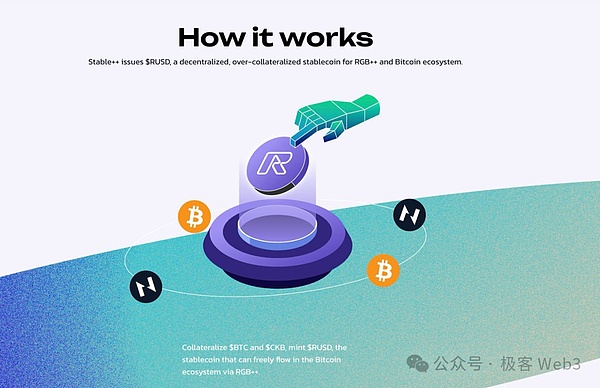
Stable++ product function and mechanism design
From the working principle, there are basically four types of common stablecoins:
-
Pure centralized stablecoin represented by USDT/USDC;
-
Stable coins that require collateral represented by MakerDAO, Undo, etc. (both purely centralized and decentralized, but the mechanism is similar);
-
CeDefi stablecoin represented by USDe (anchoring value through derivative contracts in CEX);
-
Pure algorithmic stablecoin represented by AMPL;
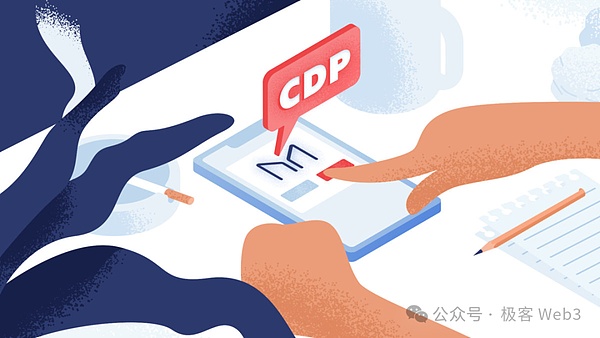
(Photo source: The Block)
Among them, MakerDAO is the representative of the CDP-mode stablecoin protocol.The so-called CDP is a debt-collateralized position, which means over-collateralizing blue-chip assets such as ETH and BTC to mint stablecoins.Because blue-chip assets have a relatively low price volatility, stablecoins based on their issuance are more risk-resistant.The lending and lending protocol in CDP mode is similar to AMM’s “point-to-pool”, and all user actions interact with the fund pool.
Here we take MakerDAO as an example.The borrower first opens a position on Maker, clarifying the amount of DAI to be generated from the CDP, and then over-collateralizes and lends DAI.When the borrower repays the loan, he returns the DAI to the Maker platform to redeem the collateral, and pays interest based on the amount and time of the DAI he lent.The loan interest here can only be paid in MKR, which is one of MakerDAO’s sources of income.
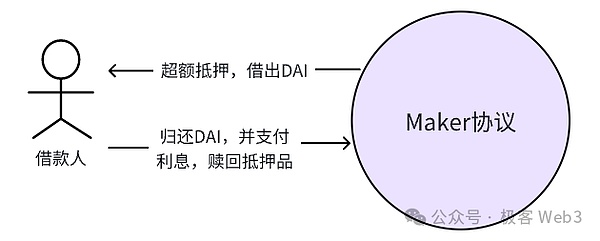
(CDP point-to-pool lending diagram)
DAI’s price anchoring mechanism depends on “Keeper”.We can simply regard the total number of DAI as constant and consist of two parts: DAI in the MakerDAO fund pool, and DAI circulating in the market outside the platform.Keeper will make arbitrage between the above two fund pools to maintain the stability of DAI prices.As shown in the figure below:
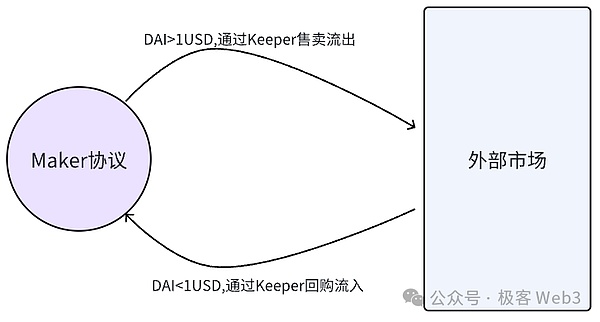
(Schematic diagram of DAI anchoring mechanism)
The protagonist of this article, Stable++, also uses CDP in mechanism design, and borrows RGB++ isomorphic binding technology to partially inherit the security of Bitcoin.From the perspective of product functions, the functions of Stable++ can be divided into several parts:
1. In Stable++,Users can lend stablecoin RUSD by over-collateralizing BTC or CKB.And if you redeem your own BTC or CKB with RUSD, there will be a handling fee for mortgage and redemption operations;
2. Users can pledge the loaned RUSD back to Stable++ to obtain Stable++’s governance token STB as a reward, and at the same time obtain the right to participate in asset liquidation.This is the main deflation scenario of RUSD. People who have been exposed to Ethena (USDe) are definitely familiar with this gameplay.In addition, you can also pledge the governance token STB back to Stable++. If you do this, you can get a certain share of the handling fee for people to mortgage and redeem the collateral according to the weight of the stake STB;
3.RUSD supports isomorphic binding and Leap functions.Through Leap, the RUSD controlled under the BTC account name can be transferred to someone else’s Cardano account name, which does not require the intervention of traditional cross-chain bridges, the security risk is very low and the process is very concise;
4. Stable++ has an LSD section, and NervosDAO users can pledge CKB to Stable++ for wstCKB.Here we explain that NervosDAO is an important part of the CKB ecosystem, and it uses certain rewards to encourage people to pledge CKB here for a long time.Now through the combination with Stable++, NervosDAO users can pledge CKB to receive rewards, while the liquidity of assets has not been lost.
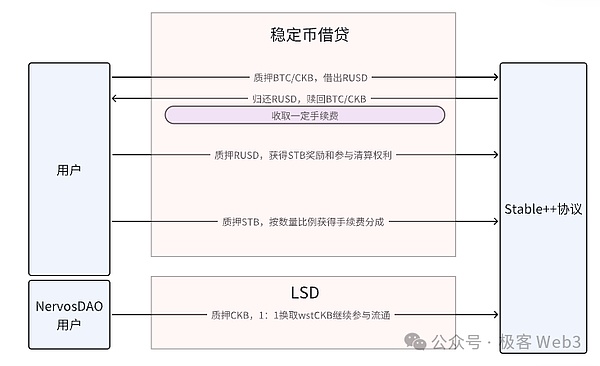
(Stable++ product function diagram)
These functions are easy to understand and need not be repeated.But we need to know,Whether a CDP stablecoin protocol is successful depends on the following aspects:
-
Reliability of collateral
-
High-efficiency liquidation mechanism
-
Can it empower the ecosystem
Below we will focus on expanding from the clearing mechanism and analyzing the specific design of Stable++.
The rationality and efficiency of the liquidation mechanism
It can be said that the liquidation component is the key gate for maintaining normal operation of the lending agreement. Stable++ has made certain innovations in the design of the liquidation mechanism, avoiding the problems in the traditional liquidation mechanism.In the Stable++ system, after the user over-mortgs the assets into the CDP component to lend a stablecoin, if the value of the collateral falls and the collateral rate falls below the threshold, the user will be liquidated if the user fails to replenish their positions in time.
The liquidation is designed to ensure that every RUSD in the system has sufficient collateral support to avoid systemic risks.During the liquidation process, the lending platform must recover some RUSD from the market, reduce the number of RUSDs in circulation, and ultimately give the RUSD issued by the platform enough collateral to support it.
Most lending agreements are liquidated in the form of a Dutch auction, and the platform sells collateral to the buyer with the highest bid (i.e., the liquidator).For example, suppose the ETH price is 4,000 US dollars and the mortgage rate for casting DAI is 2:1. The system allows you to cast up to $2,000 US dollars of DAI with 1 ETH, and you actually cast 1,000 DAIs.After a while, the ETH price fell below US$2,000, and the mortgage rate of the 1,000 DAI you cast was less than 2:1, which will trigger liquidation and the 1 ETH you mortgaged will be automatically auctioned.
The Dutch auction starts at the highest price and the auction price is gradually reduced until some buyers are willing to take over.Suppose these collaterals are auctioned from US$1,500 and finally sold to the liquidator for US$1,200. The liquidator can obtain 1 ETH collateral and obtain a certain profit.After that, the MakerDAO protocol will destroy or lock the 1,200 DAIs received, which will reduce the number of DAIs in circulation.
The above process can be automatically performed under the control of smart contracts, ensuring that the stablecoin supply in the system is always supported by sufficient collateral and removing over-leveraged positions.But in practice, there are two problems with the MakerDAO clearing mechanism:
1.The auction process takes time, and when the market falls sharply, it may be impossible to clear up bad debts.The original intention of automatic liquidation is to attract liquidators by selling collateral at a discount and transferring certain interests. If the value of collateral continues to decline, the liquidator’s willingness will be greatly reduced, and the platform may not find a suitable liquidator.
2.If the network is extremely congested and the large number of operations of self-employed liquidators are not put on the link in time, it will also affect the liquidation process.This was empirized in the May 19 incident in 2021. At that time, due to violent market fluctuations and extremely congestion in the chain, many self-employed liquidators and liquidators could not be put on the chain in time.
The above problems are reflected in mainstream lending agreements such as MakerDAO and AAVE. They are all due to the inefficient liquidation efficiency that ultimately causes losses to the platform itself and users.To address this issue,In the design of the clearing mechanism, Stable++ tends to ensure the efficiency of the clearing process as much as possible, so it has added a dual insurance mechanism of “Stability Pool Stability Pool” and “Redistribution Redistribution”.This is also the biggest highlight of Stable++ in mechanism design.
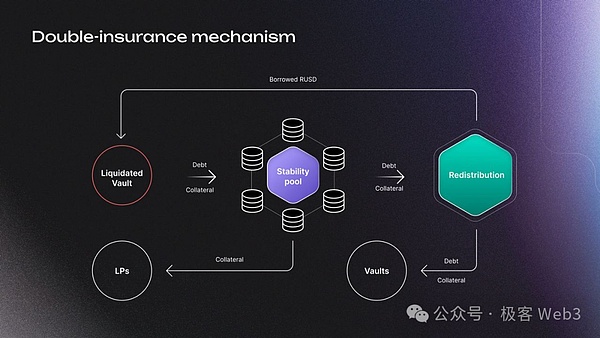
(Schematic diagram of Stable++ clearing mechanism)
In Stable++,Users can deposit stablecoins into Stability Pool (hereinafter referred to as insurance pool) and act as a “standing army” to be ready to liquidate bad positions at any time.When a liquidation event occurs, the first thing the agreement does is to liquidate the bad positions through the insurance pool, and then allocate the collateral to the insurance pool’s LP as a reward.Stability Pool changes the role of liquidator from “temporary search” to “standing army”, which is equivalent to adding an efficient buffer to the agreement, without having to temporarily find liquidator when liquidation occurs.
But here are two points to note:
1.Stability Pool currently accepts the injected stablecoins for RUSD itself.Some people may be worried: if the reserve assets in the insurance pool are RUSDs issued by the platform themselves, it seems that there is a bootstrapping (lifting yourself up).Is this reasonable?
Regarding this, it should be emphasized thatRUSD in the insurance pool will be directly destroyed when participating in liquidation.For example: Assuming the collateral rate of RUSD is 110%, there are 100 RUSDs in Stability Pool, from one LP.An existing position, minted 100 RUSD, the collateral value is $109, has triggered liquidation conditions.
When the position is liquidated, 100 RUSD in the insurance pool is directly destroyed, which means that the LP will lose 100 RUSD, obtain $109 collateral in the liquidated position and make a profit of $9.After that, the liquidator no longer needs to repay the debt of 100 RUSD.
Obviously, 100 of the RUSDs circulating in the market were destroyed, and there were also US$109 missing collateral on the platform. The bad positions that touched the 110% collateral rate red line disappeared directly, and the collateral rates of other positions on the platform were still healthy.Regarding this,We can summarize Stable++’s insurance pool design in this way:
The essence is to let some borrowers lock their RUSD positions. When a certain position is liquidated, the platform needs to destroy part of RUSD and remove bad collateral to maintain health.In MakerDAO’s liquidation mode, the destroyed DAI is provided by random liquidators on the market, while Stable++ directly provides the DAI to be destroyed by the insurance pool.Therefore, for the Stability Pool model, you can only use the stablecoins issued by Stable++ as a reserve, and you don’t have to worry about bootstrapping.
The above example also explains how the collateral discount rate obtained by the LP as Stability Pool is calculated, which is related to the CR set by the system.If we look at the 110% mortgage rate in the above case, the LP involved in the liquidation is equivalent to obtaining 109U of collateral with 100U, with a discount rate of about 9%, which is almost the same as the conventional liquidation discount (here is just a simple example, andDoes not represent the real parameters of Stable++).
However, because Stable++ uses a standing insurance pool, the liquidation speed and efficiency are much better, and there is no need to temporarily look for liquidators in the market.Conversely,How to maintain Stability Pool with sufficient liquidity to deal with liquidation is also an issue that needs to be considered.

2.If Stability Pool does not have enough stablecoins to participate in the liquidation, then Redistration will be initiated and the debts and collateral involved in the liquidated position will be redistributed proportionally across all current positions.For example, when the insurance pool cannot handle bad debts, the debts of the bad debts will become global debts and be distributed to all borrowers, such as:
There are now 100 borrowers and a position to be liquidated has 100 RUSD bad debts. Redistration will allow each borrower to bear an additional RUSD debt, but will also obtain the corresponding share of collateral as income.This is different from the redistribution mechanism of old Defi platforms such as Synthetix.Synthetix will only allocate the debts of the bad debts to existing borrowers and turn the loans into global debts, each borrower only bears additional debts without obtaining corresponding income.
Through the above two insurances, Stable++ ensures that as long as the liquidation incident occurs, it can be quickly digested as soon as possible. This efficient liquidation can effectively solve the bad debt problem in traditional lending agreements.and,This two-pronged and efficient liquidation method means that Stable++ can allow users to borrow at a lower mortgage rate (such as within 110%), greatly improving the utilization rate of funds.
In summary, CDP is essentially a form of lending. Because it is a borrowing relationship, bad debts will definitely occur, that is, the decline in the value of the collateral will lead to “insolvency”, which requires liquidation.In the two liquidation methods discussed below, both parties have their own advantages and disadvantages:
The traditional auction liquidation method with MakerDAO and Aave as examples has been tested and does not require maintenance of a huge “insurance mechanism”. Usually, as long as the liquidity of the mortgaged assets is good enough and the market acceptance is high, large-scale liquidation can be achieved.However, the disadvantages are the same as mentioned before. When encountering extreme market conditions, the efficiency is not high. In addition to several specific assets such as ETH, the liquidity of the other collateral is not high, and there are not enough liquidators to quickly help the agreement return.Normal debt levels;
Taking Stable++ and crvUSD as examples as “clearing pools” are essentially based on the asset pool controlled by the protocol as liquidator. By placing reverse orders, the liquidation can be quickly liquidated when liquidation occurs, so that the overall debt level of the agreement reaches a healthy value.But in terms of specific practices, each company has its own advantages.What is more interesting is that AAVE’s latest Safety module –umbrella also uses not to sell insurance pool assets, but to reduce bad debts through burning.
Stabl++ adopts a combustion mechanism, and the assets in the liquidation pool will be directly destroyed, and the collateral obtained will be directly distributed to the LP of the insurance pool.crvUSD is the idea of complete transaction. During liquidation, use crvUSD to purchase collateral. After the collateral price rises, these collaterals will be sold. CrvUSD is repurchased. The ownership of the entire collateral is Curve itself.
Can under-damping system be built within the ecosystem
First of all, we need to discuss it.What does a healthy economic system look like?One of its necessary conditions is that there must be a “under-damping mechanism” to counter the trend of currency price change.Underdamping (force) borrows the concept in physics, which refers to the force that “hinders” but is not enough to “block” the movement trend of objects, which will slow down the change trend of objects. In token economics, regardless of the price rises and falls, the economy.There are buffering mechanisms in the system that block but cannot prevent its changes.Such an economic system can not only maintain development without over-leverage, but also meet the conditions for a soft landing.
Bitcoin’s transaction fees and Ethereum’s Gas fee pricing model will be dynamically adjusted with the change of real-time popularity, which is a “under-damping mechanism.”on the contrary,If an asset rises or falls rapidly and the system lacks a solution to effectively mitigate its changing trends, it is an unhealthy economic system, which will eventually collapse due to excessive leverage.This is also the reason why a number of Ethereum LSD and Restaking projects have been criticized.
Since Stable++ supports collaterals mainly BTC and CKB, and they are deployed on RGB++ Layer, thenWe need to examine whether the relationship formed between Stable++ and CKB tokens is beneficial to the overall ecosystem.
In addition to the Genesis block, there are two ways to issue CKB.The first type is PoW mining, with an upper limit of 33.6 billion. The newly added CKB is reduced by half every four years. The last halving was reduced in 2023, and the annual issuance volume has been reduced from 4.2 billion to 2.1 billion.This method is called “basic issuance”.
In addition, CKB has a unique mechanism, that is, users must lock some CKBs to store data on the chain (if you hold assets on the CKB chain, there will be corresponding data to be stored and a certain storage fee will be paid).However, the Internet does not directly charge storage rent to those who lock CKBs, but instead uses inflation to dilute the value of tokens in the hands of users and collect rent in disguise. This is called “secondary issuance”.The total annual amount of secondary issuance is fixed at 1.344 billion. The distribution method of this part of token is as follows:
1. Miner:The secondary issuance CKB allocated to miners is proportional to the storage space occupied by the user on the chain.
2. NervosDAO
3. Treasury:The secondary issuance CKB allocated to the treasury is proportional to the proportion of CKB/total issuance in circulation, and this part will be directly destroyed.
Stable++ allows users to stake CKB to generate wstCKB, or use CKB to lend RUSD at a lower staking rate.When the price of CKB rises, more people will use CKB to mortgage RUSD, which can make many CKBs locked; and the cast RUSD will increase the activity of the on-chain Defi system.Overall, it is equivalent to indirectly reducing the CKB inflation rate and increasing on-chain activity, which can also allow miners to gain more benefits and mobilize their enthusiasm to improve the economic security of the entire network.
So unlike other asset mortgage stablecoins,The issuance mechanisms of Stable++ and CKB form a healthier token economic system, which can form a “under-damping mechanism” rather than simply adding leverage.With the existing CKB LST, its composability and liquidity will be further improved.
Summary: Looking at the necessity of Stable++ from a market perspective
From a market perspective, BTCfi ecosystem also needs a larger-scale decentralized stablecoin to appear.
First, stablecoins, USDT and USDC in the current crypto market account for almost 90% of the market value, but their centralized risks are difficult to ignore.As mentioned above, BTCfi users pay the most attention to security. If a decentralized stablecoin that can meet the comprehensive needs of large investors for transactions and security appears, it is a necessary condition to leverage these people to participate in BTCFi.
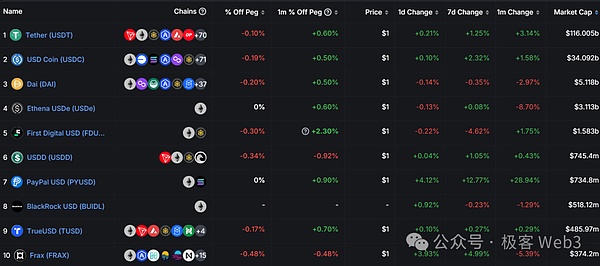
(The top ten stablecoins currently ranked in market value)
Second, the total market value of stablecoins is about 80 billion US dollars, only a fraction of the total market value of Bitcoin. From this perspective, there are still many BTCs that can be used as collateral to generate stablecoins. There are still many stablecoins based on BTC.Development potential.
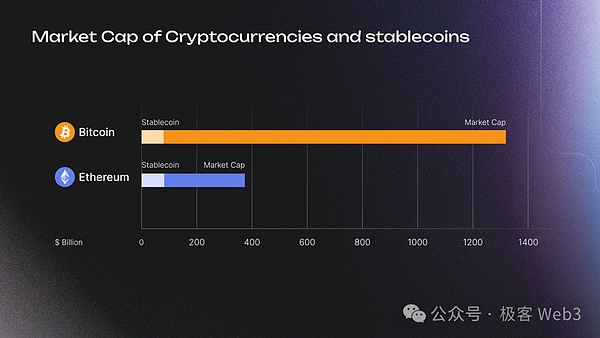
(Comparison of Bitcoin and Ethereum’s market value)
However, some stablecoins have appeared in the Bitcoin ecosystem before, but none of them have caused a major response from the market.The reason is that it happened too early and there was not enough technology to support it at that time.Nowadays, with the increasing prosperity of the RGB++ Layer ecosystem, and the gradual improvement of projects such as UTXOSwap, Stable++, and JoyID.The large infrastructure of BTCFi on CKB has just begun.The stablecoin protocol based on Bitcoin will surely bring new imagination space to the BTCFi ecosystem. CKB, a value depression, will become a fertile ground for entrepreneurs, and all visions will be promising in the future.








